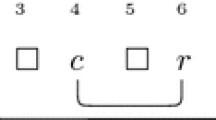Abstract
We show that the loosely guarded and packed fragments of first-order logic have the finite model property. We use a construction of Herwig and Hrushovski. We point out some consequences in temporal predicate logic and algebraic logic.
Similar content being viewed by others
References
H. Andréka, I. Hodkinson, and I. Németi, 'Finite algebras of relations are representable on finite sets', J. Symbolic Logic 64 (1999), 243-267.
H. Andréka, J. van Benthem, and I. Németi, 'Modal logics and bounded fragments of predicate logic', J. Philosophical Logic 27 (1998), 217-274.
C. Areces, C. Monz, H. de Nivelle, and M. de Rijke, 'The guarded fragment: Ins and outs', in JFAK. Essays Dedicated to Johan van Benthem on the Occasion of his 50th Birthday, J. Gerbrandy, M. Marx, M. de Rijke, and Y. Venema (eds.), Vossiuspers, Amsterdam University Press, Amsterdam, 1999, CD-ROM, ISBN 9-056-29104-1.
D. M. Gabbay, 'Expressive functional completeness in tense logic (preliminary report)', in Aspects of Philosophical Logic, U. Monnich (ed.), Reidel, Dordrecht, 1981, pp. 91-117.
E. Grädel, 'Decision procedures for guarded logics', in Automated Deduction — CADE16. Proceedings of 16th International Conference on Automated Deduction, Trento, 1999, LNCS, vol. 1632, Springer-Verlag, 1999, pp. 31-51.
_____, 'On the restraining power of guards', J. Symbolic Logic 64 (1999), 1719-1742.
M. Grohe, 'Arity hierarchies', Ann. Pure Appl. Logic 82 (1996), 103-163.
B. Herwig, 'Extending partial isomorphisms on finite structures', Combinatorica 15 (1995), 365-371.
_____, 'Extending partial isomorphisms for the small index property of many ω-categorical structures', Israel J. Math. 107 (1998), 93-124.
B. Herwig and D. Lascar, 'Extending partial isomorphisms and the profinite topology on the free groups', Trans. Amer. Math. Soc. 352 (2000), 1985-2021.
C. Hirsch and S. Tobies, 'A tableau algorithm for the clique guarded fragment', in Advances in Modal Logic 3, F. Wolter, H. Wansing, M. de Rijke, and M. Zakharyaschev (eds.), CSLI, 2001, to appear.
R. Hirsch and I. Hodkinson, 'Relation algebras from cylindric algebras, I', Ann. Pure Appl. Logic, 112 (2001) 225-266.
_____, 'Relation algebras with n-dimensional relational bases', Ann. Pure Appl. Logic 101 (2000), 227-274.
_____, 'Relation algebras by games', North-Holland, 2002, to appear.
R. Hirsch, I. Hodkinson, M. Marx, Sz. Mikulás, and M. Reynolds, 'Mosaics and step-by-step', in Logic at Work, E. Orłowska (ed.), Studies in Fuzziness and Soft Computing, vol. 24, Physica-Verlag, Heidelberg/New York, 1998, Appendix to A Modal Logic of Relations by Y. Venema and M. Marx, pp. 158–167.
I. Hodkinson, F. Wolter, and M. Zakharyaschev, 'Decidable fragments of first-order temporal logics', Ann. Pure Appl. Logic 106 (2000), 85-134.
E. Hrushovski, 'Extending partial isomorphisms of graphs', Combinatorica 12 (1992), 411-416.
J. A. W. Kamp, 'Tense logic and the theory of linear order', Ph.D. thesis, University of California, Los Angeles, 1968.
R. Maddux, 'Some varieties containing relation algebras', Trans. Amer. Math. Soc. 272 (1982), 501-526.
_____, 'A sequent calculus for relation algebras', Ann. Pure Appl. Logic 25 (1983), 73-101.
M. Marx, 'Complexity of modal logics of relations', Tech. Report ML-1997-02, ILLC, University of Amsterdam, 1997. Available at http://www.wins.uva.nl/research/illc/Publications/ResearchReports/ML-1997-02.text.ps.gz
_____, 'Tolerance logic', J. Logic, Language and Information 10 (2001), 353-373.
Sz. Mikulás and M. Marx, 'Undecidable relativizations of algebras of relations', J. Symbolic Logic 64 (1999), 747-760.
M. Reynolds, 'The complexity of the temporal logic over the reals', (1999), submitted. Available at http://www.it.murdoch.edu.au/~mark/research/online/cort.html
_____, 'The complexity of the temporal logic with until over general linear time', Journal of Computer and System Sciences, accepted subject to some small revisions being made, 2002. Earlier draft version of manuscript available at http://www.it.murdoch.edu.au/ mark/research/online/cult.html
J. K. Truss, 'Generic automorphisms of homogeneous structures', Proc. London Math. Soc. 64 (1992), 121-141.
J. van Benthem, Modal correspondence theory, Ph.D. thesis, Mathematical Institute, University of Amsterdam, 1976.
_____, Exploring logical dynamics, Studies in Logic, Language and Information, CSLI Publications & FoLLI, Stanford, 1996.
_____, 'Dynamic bits and pieces', Technical Report LP-97-01, ILLC, University of Amsterdam, 1997. Available at http://preprint.beta.uva.nl/server/bp_search.show_doc?p_srvr_id=3&p_doc_id=468
_____, Modal logic and classical logic, Bibliopolis, Naples, 1985.
M. Vardi, 'Why is modal logic so robustly decidable?', in Descriptive complexity and finite models, N. Immerman and Ph. Kolaitis (eds.), DIMACS Series in Discrete Mathematics and Theoretical Computer Science, vol. 31, Amer. Math. Soc, Providence, RI, 1997, pp. 149-184.
Author information
Authors and Affiliations
Rights and permissions
About this article
Cite this article
Hodkinson, I. Loosely Guarded Fragment of First-Order Logic has the Finite Model Property. Studia Logica 70, 205–240 (2002). https://doi.org/10.1023/A:1015178417181
Issue Date:
DOI: https://doi.org/10.1023/A:1015178417181




